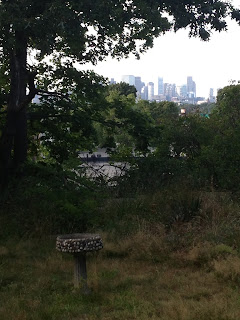14 Aug HBI Explores Baseball Hall of Famer George Wright’s Savin Hill Estate
 |
| Wright as a Boston Red Stocking. |
Last month, the HBI checked out the home of baseball’s first superstar, George Wright, at 24 Grampian Way. Located on a ridge in Savin Hill that overlooks Dorchester Bay, the stick-style house has a truly unique and impressive view of Downtown Boston.
When baseball became a professional sport in 1869, Wright quickly inked baseball’s highest paying contract, earning $1400 for a nine-month season with the Cincinnati Red Stockings. Wright signed the contract after playing half a decade of amateur baseball and cricket for various clubs in New York, Philadelphia, and Washington D.C. When Wright was 22, the Red Stockings, managed by his brother Harry, toured the continent undefeated. However, the Cincinnati Red Stockings dropped professionalism during their second season. George and Harry Wright started a new team in Boston with three of their former teammates but kept the same nickname. In 1871, George and Harry’s relocated Red Stockings became Boston’s first professional baseball team.
Wright and his teammates dominated the National Association of Baseball Players for four straight years, eventually leaving to join the nascent National League as a founding member in 1876. The National League would later later join with the American League (founded in 1901) to form Major League Baseball. On April 22, 1976, George Wright lead off against the Philadelphia Athletics to take the first pitch in National League history, and in effect, the first pitch of modern professional baseball.
 |
| The view from 24 Grampian Way, Savin Hill. |
After winning back to back National League pennants in 1877
and 1878 with Boston, the nascent Providence National League club hired Wright as a player-manager. Wright’s hard work and leadership made an immediate impact and the Providence Grays took home the NL pennant in their first year as professionals. The Grays have a putative claim to being the first MLB club to field an African-American player: William Gray White, a Brown University student, played his only game of professional baseball for the Grays under Wright’s management in 1879.
Wright began what would become a successful sporting goods retail career during the time period as well. Wright & Ditson became a nationally-known sporting goods company and it still exists to this day.
Success appeared to follow Wright wherever he went, from Cincinnati to Boston, baseball to business, and his two sons shared the same winning aura. Both Wright children excelled at tennis and each won the U.S. Championship. The older of the two children, Beals, also won an Olympic gold medal. They were raised in the house at 24 Grampian Way, which Wright purchased in 1887.
Wright was also instrumental in popularizing golf in the United States. Obituaries in both The Boston Globe and The New York Times credited him as the father of golf in the United States. Wright played in Franklin Park’s first game of golf and laid out a course that would later turn into the Donald Ross Course that we see today. Francis Ouimet, the first amateur to win the U.S. Open Golf Tournament (who Shia LaBeouf later portrayed in the 2005 blockbuster The Greatest Game Ever Played) was an employee at Wright & Ditson who Wright had taken a special interest in. George Wright also donated land to create Boston’s second municipal golf course in Hyde Park which now bears his name.
 |
| A 2013 view of the house and stable (far left) that Wright once converted to a state of the art squash court. |
Wright was one of the first players elected to Baseball’s Hall of Fame after its founding in 1936. Only Ty Cobb and Babe Ruth preceded him, as they were the only two elected into the hall during its inaugural year. The other members of Wright’s 1937 class of inductees were Cy Young and Connie Mack.
Historic Boston visited the house in July to assess its potential as a future project. We found ourselves blown away by Wright’s key role in the popularization of two major sports and his family’s astonishing athletic pedigree. We also loved the house’s mansard roof, large porch, and spectacular view of Downtown Boston. The Boston Landmarks Commission began its decision-making process on Tuesday, August 13, to designate it a landmark.



